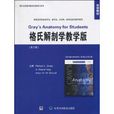《格氏解剖學教學版》是2010年6月1日北京大學醫學出版社出版的圖書,作者是杜雷克(RichardL.Drake)。
基本介紹
- 書名:格氏解剖學教學版
- 作者:杜雷克(RichardL.Drake)
- 出版社: 北京大學醫學出版社
- 出版時間:2010年6月1日
圖書信息,作者簡介,內容簡介,圖書目錄,
圖書信息
書 名: 格氏解剖學教學版
作 者:杜雷克(RichardL.Drake)
出版時間: 2010年6月1日
ISBN: 9787811169218
開本: 16開
定價: 248.00元
作者簡介
編者:(美國)杜雷克(Richard L.Drake) (美國)A.Wayne Vogl (美國)Adam W.M.Mitchell
內容簡介
作為特別為全球醫學生打造的權威教科書,該書最鮮明的特色是注重解剖學知識的臨床套用,將表面解剖學、診斷影像學、臨床病例的學習融入解剖學基礎知識的講述中,充分體現了立足臨床的編寫理念。全書包含1000餘幅原創高清示意圖,並且同一結構在不同圖片中使用相同顏色,使人體解剖結構的定位更加簡明、清晰。與前一版相比,第2版更新並調整了“概論”、“腹部”等章節內容.既涵蓋本領域最新進展。也使知識架構更加科學。超過100名全球知名學者組成了該書的國際顧問委員會,有效地保證了全書內容的準確性、先進性、易讀性。
圖書目錄
1 The body
What is anatomy?
How can gross anatomy be studied?
Important anatomica,terms
Imaging
Diagnostic imaging techniqrues
Nuclear medicine imaging
Image interpretation
Plain radiography
Computed tomography
Magnetic resonance imaging
Nuclear medicine imaging
Safety in imaging
Body systems
Skeletal system
Cartilage
Bone
J0ints
Skin and fascias
Skin
Fascia
MUSCUlar sysfem
Cardiovascular system
Lymphatic system
Lymphatic vessels
Lymph nodes
Lymphatic trunks and ducts
Nervoussystem
CentraI nervous system
Functional subdivisions of the CNS
Somatic part of the nervous systerm
Viscer of part of the nervous systerm
0ther systems
LnlCaI CaSeS
2 Back
Conceptual overview
General description
Functions
Support
Movement
Protection of the nervous system
Component parts
Bones
Muscles
Vertebral canal
Spinal nerves
Relationship to other regions
Head
Thorax,abdomen,and pelvis Limbs
Key features
Long vertebral column and short spinal cord
Intervertebral foramina and spinal nerves
Innervation of the back
Regional anatomy
Skeleta,framework Vertebrae
Intervertebral foramina
Posterior spaces between vertebral arches Joints
Joints between vertebrae in the back
Ligaments
Anterior and posterior longitudinal ligaments
Ligamenta flava
Supraspinous ligament and ligamentum nuchae
Interspinous ligaments
Back musculature
Superficial group of back muscles
Intermediate group of back muscles
Deep group of back muscles
Suboccipital muscles
Spinal cord
Vasculature
Meninges
Arrangement of structures in the vertebral
Canal
Spinal nerves
5urtace anatomy
Back surface anatomy
Absence of lateral curvatures
Primary and secondary curvatures in the sagittal plane
Useful nonvertebraI skeletaIlandmarks
How to identify specific vertebral spinous processes
Visualizing the inferior ends of the spinal cord and subarachnoid space
Identilying major muscles
ClinicaI cases
3 Thorox
Conceptual overview
General description
Functions
Breathing
Protection of vital organs
Conduit
Component parts
Thoracic wall
Superior thoracic aperture
Inferior thoracic aperture
Diaphragm
Mediastinum
PleuraI cavities
Relationship to other regions
Neck
Upper limb
Abdomen
Breast
Keyfeatures
VertebralleveI TIV/V
Venous shunts from left to right
Segmental neurovascular supply of thoracic wall
Sympathetic system
Flexible wall and inferior thoracic aperture
Innervation of the diaphragm
Regional anatomy
Pectoral region
Breast
Muscles of the pectoral region
THoracic wall
SkeletaI framework
Intercostal spaces
Diaphragm
Venous drainage
Innervation
Movements of thethoracic wall and diaphragm during breathing
Pleural cavities
Pleura
Lungs
Mediastinum
Middle mediastinum
Superior mediastinum
Posterior mediastinum
Anterior mediastinum
Surface anatomy
Thorax surface anatomy
How to count ribs
Surface anatomy of the breast in women
Visualizing structures at the TIV/V vertebral Ievel
Visualizing structures in the superior mediastinum
Visualizing the margins of the heart
Where to Iisten for heart sounds
Visualizing the pleural cavities and lungs,pleural recesses,and lunq Iobes and fissures
Where to listen for lung sounds
ClinicaI cases
4 Abdomen
Conceptual overview
General description
Functions
Houses and protects major viscera
Breathing
Changes in intra-abdominal pressure
Component parts Wall
Abdominal cavity
Inferior thoracic aperture
Diaphragm
Pelvic inlet
Relationship to other regions
Thorax
Pelvis
Lower limb
Keyfeatures
Arrangement of abdominal viscera in the Adult
Viscera
Defining surface regions to which pain from the gut is referred
Where to find the kidneys
Where to find the spleen
Clinical cases
5 Pelvis and perineum
Conceptual overview
General description
Functions
Contain and support bladderf rectum,anal canal,and reproductive tracts
Anchors the roots of the externaI genitalia 408
Component parts
Pelvic inlet
Pelvic walls
Pelvic outlet
Pelvic floor
Pelvic cavity
Perineum
Relationship to other regions
Abdomen
Lower limb
Keyfeotures
The pelvic cavity projects posteriorly
Important structures cross the ureters in the pelvic cavity
The prostate is anterior to rectum
The perineum is innervated by sacral spinal cord segments
Nerves are related to bone
Parasympathetic innervation frOm spinal cord levels
S2 to S4 controls erection
Muscles and fascia of the pelvic floor and perineum
intersect at the perineal body
Gender determines the cou rse of the urethra
Regional anatomy
Pelvis
Bones
Joints
0rientation
Gender difierences
True pelvis
Viscera
Fascia
Peritoneum
Nerves
Blood vessels
Lymphatics
Perineum
Borders and ceiling
Ischio-anal fossae and their anterior recesses
Anal triangle
Urogenital triangle
Somatic nerves
Visceral nerves
Blood vessels
Veins
Lymphatics
Surface anatomy
Su rface anatomy of the pelvis and perineum
Orientation of the pelvis and perineum in the anatomical position
How to define the margins of the perineum
Identification of structu res in the anal triangle
Identification of structures in the u rogenital triangle of women
Identification of structures in the urogenital triangle ofmen
ClinicaI Cases
6 Lower limb
Conceptual overview
General introduction
Function
Support the body weight
Locomotion
Component parts
Bones and joints
Muscles
Relationship to other regions
Abdomen
Pelvis
Perineum
Keypoints
Innervation is by lumbar and sacral spinal
Nerves
Nerves related to bone
Superficial veins
Regional anatomy
Bony pelvis
ProximaI femur
Hip joint
Gateways to the lower Iimb
Nerves
Arteries
Veins
Lymphatics
Deep fascia and the saphenous opening
FemoraI triangle
Gluteal region
Muscles
Nerves
Arteries
Veins
Lymphatics
Thigh
Bones
Muscles
Arteries
Veins
Nerves
Knee ioint
Tibiofibular joint
Popliteal fossa
Leg
Bones
Joints
Posterior compa rtment of leg
Lateral compartment of leg
Anterior compa rtment of leg
_0at
Bones
Joints
Tarsal tunnel,retinacula,and arrangement of major
structu res at the ankle
Arches of the foat
Plantar aponeurosis
Fibrous sheaths of toes
Extensor hoods
Intrinsic muscles
Arteries
Veins
Nerves
Surface anatomy
Lower limb surface anatomy
Avoiding the sciatic nerve
Finding the femoral artery in the femoral
triangle
Identifying structu res around the knee
Visualizing the contents of the popliteal fossa
Finding the tarsal tunnel——the gateway to thefoot
Identifying tendons around the ankle and in the foot
……
7 Upper limb
8 Head and neck

